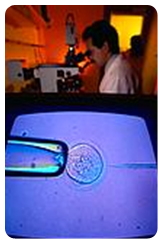Recurrent Miscarriage & Infertility

Preimplantation genetic diagnosis (PGD) dramatically improve the chance of a successful IVF pregnancy in couples where prior IVF failures have remained unexplained. It has been estimated that over half of all IVF failures are not able to be explained by an apparent problem with embryo "quality". For many couples however, this statistic is quite misleading. Most IVF centers look very closely at the appearance of embryos under the microscope as they attempt to determine a "good" or "high quality" embryo from those of lesser quality. Generally, embryos are given "good" marks when they demonstrate an appropriate number of cell divisions at a given time in their growth cycle, when the individual cells of the embryo appear to have a uniform size and when there is an absence of cellular "fragments" that may or may not represent problems in the growth progress of the embryo.
Recent advances however, have shown that even embryos receiving the highest ratings from scientists based on their "normal" or "excellent" appearance under the microscope may, in fact be highly abnormal and totally incapable of ever producing a pregnancy. This discovery was brought about by the addition of preimplantation genetic diagnosis (PGD) to the tools available to scientists in the IVF laboratory. PGD has offered physicians and scientists, for the first time ever, the ability to examine far beyond the superficial appearance of an embryo. We are now able to examine the most important internal genetic code of the embryo as well. And with these new genetic tools, we have come to learn that some embryos that appear on the surface to be of the highest quality may carry a genetic code that makes them poor choices for attempting to establish a healthy pregnancy. We have also now learned that other embryos that might have been classified as less than optimal based on their appearance, and may not have been selected for return to the mother may in fact be of the finest quality and have ten or twenty times more chance of producing a healthy pregnancy than those that would have been selected without the use of the remarkable new PGD tools. That beauty in an embryo is more than skin deep has now been confirmed by science. The technique has also allowed confirmation, for the first time, of the suspicions of our IVF scientists that simply observing and grading the appearance of an embryo may fall far short of being able to provide reliable information to patients who have failed IVF.
PGD is helpful for patients with unexplained infertility, recurrent miscarriages, unsuccessful IVF cycles, advanced maternal age, or male factor infertility. In those cases, the most likely cause is a chromosome abnormality.
Chromosome abnormalities include aneuploidy and structural abnormalities. Aneuploidy is the most common chromosomal abnormality. Aneuploidy can occur in both eggs and sperm. Structural abnormalities include translocations, inversions, and deletions. Structural chromosome abnormalities can also be present in eggs and sperm. The transmission of a chromosome abnormality to an embryo can result in a low implantation rate, miscarriage or the birth of a baby with a genetic disorder. Using Fluorescence In Situ Hybridization (FISH), the scientists in our PGD laboratory can identify the absence of these specific genetic disorders in each normal developing embryo. As a result, only those embryos free of genetic disease will be transferred to the patient’s uterus so as to increase the chance of conception and ultimately a healthy baby.
Recurrent First-trimester Pregnancy Loss
Recurrent pregnancy loss (defined as three or more miscarriages in a row) affects approximately 1% of the population. The evaluation of these patients should first rule out genetic, anatomic, endocrine, and immunologic causes for recurrent miscarriage. Many doctors will also test for genetic blood clotting disorders, although this remains controversial. The medical evaluation recurrent miscarriage should be individualized, but typically includes a physical examination; pelvic ultrasonography, hysterosalpingography, or saline hysterosonography to evaluate the uterus; complete blood cell count; testing for thyrotropin, antithyroid antibodies, prolactin, lupus anticoagulant, anticardiolipin, and antiphosphatidylserine antibodies; karyotyping (chromosomal analysis) of both partners; and possibly an endometrial biopsy (biopsy of the lining of the uterus) and screening for genetic blood clotting disorders.
Approximately 5% to 8% of couples with a history of recurrent pregnancy loss have an abnormal karyotype, usually a balanced translocation. A balanced translocation is a rearrangement of chromosomes in an otherwise normal person that markedly increases that persons risk of producing abnormal eggs or sperm, leading to an increased risk for miscarriage and birth defects. PGD can be performed for couples with a balanced translocation, allowing them to implant only chromosomally balanced embryos, thus reducing their risk of miscarriage. The use of PGD for translocations is technically more complicated than for aneuploidy. Patients with a translocation should be referred to a genetics counselor to review their options. A referral for PGD at a center with experience in this type of analysis can then be made if the couple desires it.
Fertile couples with repeated miscarriages should be evaluated for the presence of a chromosomal abnormality. The female or male partner may be a carrier of a balanced translocation or be an aneuploid mosaic.
Even after undergoing a complete work-up, many couples have no identifiable cause for their miscarriages, and therefore no standard treatment options. Without treatment, couples with recurrent miscarriage have a 55% to 70% chance of a successful live birth, depending on how many miscarriages they have had and whether they have any previous normal full-term pregnancies. Thus, expectant management with close follow-up (no treatment or intervention) is a reasonable option for these patients. For couples desiring a more aggressive approach, PGD may be offered for significant reduction (by more than 50%) of the risk of first-trimester miscarriage due to an abnormal number of chromosomes.